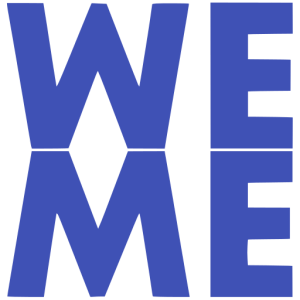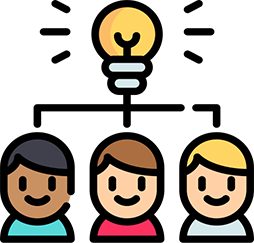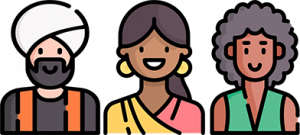Chapter 8: Customer Service in a Diverse World
Chapter 8 Learning Outcomes
 After reading this chapter, you should be able to know and learn the following:
After reading this chapter, you should be able to know and learn the following:
-
-
- Identify the benefits of diversity in the workplace.
- Discuss strategies for dealing with diverse customers.
- Discuss unconscious bias and strategies to address it.
-
Introduction
When you’re building a team, you don’t want twenty people who all think, act and believe the same. You want a thriving workplace where everyone has different perspectives and can bring new and exciting ideas to the table.
When diversity, equity and inclusion are brought up, they tend to be banded together. Though this is common, it’s important to note that they mean completely different things. While it’s true that you can’t have one without the other, there are key differences that separate the three. But what exactly is the difference ?We’ll take a closer look at the differences and how making sure that workplaces have plenty of each, is important.
Watch “What is Diversity, Equity and Inclusion?” YouTube video to introduce the key differences between these terms and how it impacts business today.[1] Closed-captioning is available on YouTube.
To summarize:
Diversity can be defined as the practice of including people from a range of different aspects of life. These could be personal, physical and social characteristics. This includes but is not limited to gender, ethnicity, age, income and education. It can also be various physical or mental disabilities and sexual orientation.
Equity aims to ensure fair treatment, access, equality of opportunity and advancement for everyone while also attempting to identify and remove the barriers that have prevented some groups from fully participating. As such, companies that adopt equity practices don’t establish one-size-fits-all policies. Rather they take individual needs into consideration, while also readjusting organizational structures to account for the disadvantages minority groups face.
Inclusion builds a culture where everyone feels welcome by actively inviting every person or every group to contribute and participate. This inclusive and welcoming environment supports and embraces differences and offers respect to everyone in words and actions. A work environment that’s inclusive is supportive, respectful and collaborative and aims to get all employees to participate and contribute. An inclusive work environment endeavors to remove all barriers, discrimination and intolerance.
In business, this is the ability to integrate everyone within the workplace and create a safe and inclusive atmosphere. It’s allowing people’s differences to coexist in a mutually beneficial way.
This chapter will focus on the management of diversity.
Benefits of Diversity
What is the business case for diversity? Having and managing a diverse workforce effectively has the potential to bring about several benefits to organizations.
Higher Creativity in Decision Making

An important potential benefit of having a diverse workforce is the ability to make higher quality decisions. In a diverse work team, people will have different opinions and perspectives. In these teams, individuals are more likely to consider more alternatives and think outside the box when making decisions. Research also shows that diverse teams tend to make higher quality decisions.[2]
There’s a fascinating correlation between being exposed to other cultures and creativity. So, what is it about multicultural experiences that enhances creativity?
Forbes reports that diverse teams are more creative because a person’s individual creativity is enhanced by their ability to integrate different points of view—something that many of us learn when interacting with people from different backgrounds. In fact, multicultural experiences have been found to improve awareness of the underlying connections between different ideas, as well as enhance idea flexibility.
Therefore, having a diverse workforce may have a direct impact on a company’s bottom line by increasing creativity and innovation in decision making.
Better Understanding and Service of Customers

A company with a diverse workforce may create products or services that appeal to a broader customer base. For example, PepsiCo Inc. planned and executed a successful diversification effort in the recent past. The company was able to increase the percentage of women and ethnic minorities in many levels of the company, including management. The company points out that in 2004, about 1% of the company’s 8% revenue growth came from products that were inspired by the diversity efforts, such as guacamole- flavored Doritos chips and wasabi-flavored snacks. Similarly, through Jazz Aviation’s formal “Jazz Lends a Hand” community program, employees can apply for a paid day off to volunteer with a charity of their choosing. Jazz Aviation offers scholarships to students enrolled in Aircraft Maintenance Engineer (AME) programs at local community colleges and provides mentoring to apprentice AMEs. In addition, the company maintains a tool purchase program, an interest-free payment program to help AMEs spread the cost of tools over an extended period. “For Jazz, diversity is not a program, it is core to the makeup of our people and business. To be a leader in our industry and to have a competitive advantage, Jazz celebrates differences and values the uniqueness that everyone has to offer” (Chorus Aviation Inc., 2019).
A company with a diverse workforce may understand the needs of groups of customers better, and customers may feel more at ease when they are dealing with a company that understands their needs.
More Satisfied Workforce

When employees feel that they are fairly treated, they tend to be more satisfied. On the other hand, when employees perceive that they are being discriminated against, they tend to be less attached to the company, less satisfied with their jobs, and experience more stress at work.[3] Organizations where employees are satisfied often have lower turnover.
Mastercard consistently makes it into the Top 10 of DiversityInc’s 50 Best Companies for Diversity list. They believe that “diversity is what drives better insights, better decisions, and better products. It is the backbone of innovation”. A particularly unique project that Mastercard has executed over the past few years involves getting older employees in the company more active when it comes to social media. To address generational barriers, “YoPros” BRG (the Young Professionals Business Resource Group) offers a one-on-one ‘Social Media Reverse Mentoring’ program to older employees who want to become familiarized with the platforms.
At Coca-Cola, diversity is seen “as more than just policies and practices. It is an integral part of who we are as a company, how we operate and how we see our future.” With its new paid family leave policy for all parents and caregivers, Coca-Cola is committing to the health and well-being of all employees and their families. Many LGBT people build their families through adoption, and additional time at home helping a baby or child transition into a new family environment is important. Likewise, for single parents who are LGBT, this extended paid leave allows more time to secure their child’s well-being, including finding reliable childcare.
Market Reputation

Companies that do a better job of managing a diverse workforce are often rewarded in the stock market, indicating that investors use this information to judge how well a company is being managed.
Although gender, generations, and sexual orientation are all part of the diversity hiring strategy at Sodexo, (a French food services and facilities management company that operates in 55 countries) they state that “gender balance is our business”, and their mission is to make it everyone else’s business too. 55% of all staff members in Sodexo are women – that’s up from just 17% in 2009. 58% of the members on the board of directors are female and the company runs 14 Gender Balance Networks worldwide. What they have found is that when there is an optimal gender balance within an organization, employee engagement increases by 4 percentage points, gross profit increases by 23% and brand image strengthens by 5 percentage points.
The Canadian Women’s Foundation states that women make up just over half of the Canadian population, yet continue to be underrepresented in political and professional leadership positions.[4] Barriers to leadership multiply for women who face intersecting forms of discrimination, such as racism, colonialism, ableism, (discrimination in favor of able-bodied people) and homophobia (the fear, hatred, discomfort with, or mistrust of people who are lesbian, gay, or bisexual). This has a significant impact on organizations that have biased preferences and could lead to poor reputation and business results.
Ekta Mendhi is Vice president- Technology, Infrastructure and Innovation at CIBC in Canada. She had served as the co-chair of Women in Capital Markets’, Women in Leadership Network, and co-founded the Canadian Gender and Good Governance Alliance. They found through their research that creating a more diverse board of directors can enhance decision-making process and augment an organization’s performance and market reputation.[5]
New industries such as the Canadian Cannabis industry is not exempt from these diversity considerations. A report by Marijuana Business Daily reports that “Cannabis companies in Canada with “monoculture and mono-gender” boardroom compositions could face a competitive disadvantage and will ultimately take a hit to their bottom lines.”[6]
Lower Litigation Expenses

Companies doing a particularly bad job in diversity management face costly litigations. When an employee or a group of employees feel that the company is violating equity laws, they may file a complaint. The Ministry of Labour (MOL) in Canada acts as a mediator between the company and the person in cases where litigation is claimed due to unfair or unequal hiring practices, and the company may choose to settle the case outside the court. If no settlement is reached, the MOL may sue the company on behalf of the complainant or may provide the injured party with a right-to-sue letter. Regardless of the outcome, these lawsuits are expensive and include attorney fees as well as the cost of the settlement or judgment, which may reach millions of dollars. The resulting poor publicity also has a cost to the company.[7]
Shareholders interested in corporate diversity policies or in protecting their investment from future allegations of misconduct are turning more toward securities litigation to hold companies accountable. A recent example of this is an investor lawsuit filed against Tesla Inc. which accuses the company’s leadership of exposing Tesla to potential liability by allowing a “toxic workplace culture” to exist.[8] Google, Inc. and L. Brands Inc. settled similar lawsuits and pledged millions of dollars to change corporate practices and towards diversity/equity initiatives. Pressure from investors has also led to broader disclosures. “Making this information public pushes companies to improve diverse hiring and retention, which can help avoid costly employment discrimination lawsuits or public relations scandals.”[9]
Higher Company Performance

If a company isn’t viewed as being inclusive, some customers (including both in the B2B and B2C marketplaces) may shy away from giving you their business.
This is especially true with Millennial (anyone born from 1981 to 1996) and Gen Z (anyone born from 1997 to 2012) customers. These two generations are incredibly socially conscious. As a result, they may prefer inclusive companies when considering purchases in both their personal and professional lives. If you aren’t seen as supporting diversity, you may miss out on opportunities to increase sales, foster strong customer relationships, and ultimately enhance your profitability.
As a result of all these potential benefits, companies that manage diversity more effectively tend to outperform others. Research shows that there is a positive relationship between racial diversity of the company and company performance.[10] Companies ranked in the Diversity 50 list created by DiversityInc magazine performed better than their counterparts.[11]
Challenges of Diversity
If managing diversity effectively has the potential to increase company performance, increase creativity, and create a more satisfied workforce, why aren’t all companies doing a better job of encouraging diversity? Despite all the potential advantages, there are also several challenges associated with increased levels of diversity in the workforce.
1. Similarity-Attraction Phenomenon
There is a tendency for people to be attracted to people similar to themselves.[12] Research shows that individuals communicate less frequently with those who are perceived as different from themselves.[13] They are also more likely to experience emotional conflict with people who differ with respect to race, age, and gender.[14][15] Individuals who are different from their team members are more likely to report perceptions of unfairness and feel that their contributions are ignored.[16]
The similarity-attraction phenomenon may explain some of the potentially unfair treatment based on demographic traits. It embodies the popular adage, “birds of a feather flock together.”
If a hiring manager chooses someone who is racially similar over a more qualified candidate from a different race, the decision will be unfair. In other words, similarity-attraction may prevent some highly qualified women, minorities, or persons with disabilities from being hired. Of course, the same tendency may prevent highly qualified Caucasian and male candidates from being hired as well but given that Caucasian males are more likely to hold powerful management positions in today’s U.S.-based organizations, similarity-attraction may affect women and minorities to a greater extent. Even when candidates from minority or underrepresented groups are hired, they may receive different treatment within the organization.
For example, research shows that one way in which employees may get ahead within organizations is through being mentored by a knowledgeable and powerful mentor. Yet, when the company does not have a formal mentoring program in which people are assigned a specific mentor, people are more likely to develop a mentoring relationship with someone who is similar to them in demographic traits.[17] This means that those who are not selected as protégés will not be able to benefit from the support and advice that would further their careers. Similarity-attraction may even affect the treatment people receive daily. If the company CEO constantly invites a male employee to play golf with him while a female employee never receives the invitation, the male employee may have a serious advantage when important decisions are made.
Faultlines

A faultline is an attribute along which a group is split into subgroups. For example, in a group with three female and three male members, gender may act as a faultline because the female members may see themselves as separate from the male members. Now imagine that the female members of the same team are all over 50 years old and the male members are all younger than 25. In this case, age and gender combine to further divide the group into two subgroups. Teams that are divided by faultlines experience a number of difficulties. For example, members of the different subgroups may avoid communicating with each other, reducing the overall cohesiveness of the team. Research shows that these types of teams make less effective decisions and are less creative.[18][19] Faultlines are more likely to emerge in diverse teams, but not all diverse teams have faultlines. Going back to our example, if the team has three male and three female members, but if two of the female members are older and one of the male members is also older, then the composition of the team will have much different effects on the team’s processes. In this case, age could be a bridging characteristic that brings together people divided across gender.
Research shows that even groups that have strong faultlines can perform well if they establish certain norms. When members of subgroups debate the decision topic among themselves before having a general group discussion, there seems to be less communication during the meeting on pros and cons of different alternatives. Having a norm stating that members should not discuss the issue under consideration before the actual meeting may be useful in increasing decision effectiveness.[20]
Stereotypes
Your boss informed you that they need your assistance in training a new hire, Unax Uceda, in two weeks. Stop right there. What went through your mind when you read the new hire’s name? Did you make any assumptions about the person based on their name? To process all the information you’re exposed to on a daily basis, your brain creates shortcuts, which are called stereotypes.
Stereotypes are generalizations about a particular group of people. This stereotype may be based on your past experience with someone of a similar age, gender, ethnicity, background, education, etc., or your cultural biases and prejudices (which we all have). An important challenge of managing a diverse workforce is the possibility that stereotypes about different groups could lead to unfair decision making.
The assumption that women are more relationship oriented, while men are more assertive is an example of a stereotype. The problem with stereotypes is that people often use them to make decisions about a particular individual without actually verifying whether the assumption holds for the person in question. As a result, stereotypes often lead to unfair and inaccurate decision making. For example, a hiring manager holding the stereotype mentioned above may prefer a male candidate for a management position over a well-qualified female candidate. The assumption would be that management positions require assertiveness and the male candidate would be more assertive than the female candidate.
Stereotyping can cause low morale for the individual or group impacted and could potentially make for a toxic work environment. Employees who face constant comments, criticisms or other negative results from stereotyping can lose motivation and interest in performing their jobs, lower their productivity and lead to turnover. Stereotype threats can reduce job engagement, career aspirations, and receptivity to feedback.
Workplace stereotyping has short and long-term consequences. Let’s review three effects.
- Culture. Company culture has a substantial impact on profitability. Workplace stereotypes are a massive roadblock to improving culture because it hampers employees’ sense of belonging at the company.
- Talent. Stereotyping can prevent hiring managers from finding the best candidate for the job or prevent applicants from even wanting to apply to your positions. Candidates often screen companies using various websites to get an insider view before applying. Here are a few things they will take notice of.
- Are all senior leadership one gender or ethnicity?
- Are all the pictures of one ethnic group, or is there diversity?
- They might review your company’s LinkedIn account to get a feel for how long people stay at the company. If they find someone like them, they may reach out about the employee’s experience of working for you.
- There are many company review websites that allow candidates to read employee or previous employees’ comments about working for the company and how they felt about leadership.
- Legal. If workplace stereotypes go unchecked, they can lead to workplace discrimination. Being sued for workplace discrimination takes time and financial resources and damages your company’s image.
Being aware of stereotypes is the first step to preventing them from affecting decision-making.
Neurodiversity
If you perceive your classmate to be a slow learner, highly erratic in behavior, unable to make eye contact, displays variability socially, in learning, attention and moods, would you consider this classmate to be disabled? Would you classify your classmate as a disabled stereotype?
Neurodiversity describes the idea that neurological differences like autism, ADHD, and dyslexia are natural human variations that have benefits. The term “neurodivergent” describes people whose brain differences affect how their brain works. That means they have different strengths and challenges from people whose brains don’t have those differences. The possible differences include medical disorders, learning disabilities and other conditions. The possible strengths include better memory, being able to mentally picture three-dimensional (3D) objects easily, the ability to solve complex mathematical calculations in their head, and many more.
Neurodivergent isn’t a medical term. Instead, it’s a way to describe people using words other than “normal” and “abnormal.” That’s important because there’s no single definition of “normal” for how the human brain works.
The word for people who aren’t neurodivergent is “neurotypical.” That means their strengths and challenges aren’t affected by any kind of difference that changes how their brains work.
Dr. Nick Walker, a leading thinker in the emergent field of neurodiversity studies, says,” Neurodiversity is a natural, healthy, and important form of human biodiversity — a fundamental and vital characteristic of the human species, a crucial source of evolutionary and creative potential.”
Research has shown that people with autism often outperform others in auditory and visual tasks and do better on non-verbal tests of intelligence. A study by University of Montreal found that in a test that involved completing a visual pattern, people with autism finished 40% faster than those without the condition.
What neurodiverse persons may lack in social skills, they can make up for with other talents such as attention to detail, the ability to stick to a routine, and to recognize patterns. A person with ADHD (attention deficit hyperactivity disorder), for example, can bring in creativity and innovation, and not get tired easily.
We have to first get rid of our assumptions about neurodiversity and find the right person for the right job based on individual strengths and interests.
Further Reading
Click on the following website links for articles about neurodivergence in the workplace:
Some commonly occurring neurodivergent behaviors
Attention Deficit Hyperactivity Disorder (ADHD) is one of the most common neurodevelopmental disorders of childhood. It is usually first diagnosed in childhood and often lasts into adulthood. Children with ADHD may have trouble paying attention, controlling impulsive behaviors (may act without thinking about what the result will be), or be overly active.
Autism, or autism spectrum disorder (ASD), refers to a broad range of conditions characterized by challenges with social skills, repetitive behaviors, speech and nonverbal communication.
Dyslexia is a learning disorder that involves difficulty reading due to problems identifying speech sounds and learning how they relate to letters and words (decoding). Also called a reading disability, dyslexia is a result of individual differences in areas of the brain that process language.
Is being neurodivergent a disability?
Some neurodivergent people struggle because of systems or processes that don’t give them a chance to show off their strengths or that create new or more intense challenges for them.
- Example #1: Many people who are neurodivergent struggle in social situations, which can make it hard to find work because they struggle during job interviews. However, they can still get the job if the hiring process emphasizes their abilities, such as screening potential hires with a skills test. Once on the job, their attention to detail means they’re an outstanding accountant or record-keeper because they can easily process data that others might find more tedious.
- Example #2: Some who are neurodivergent struggle in noisy environments or situations. That means a busy office can feel overwhelming to them. However, a pair of noise-canceling headphones might give them the quiet they need to make them the most productive person on their team because one of their strengths is the ability to focus on their work intensely.
In both examples, accommodations helped the person overcome their particular struggle. For someone with a disability, an accommodation is a way to accept that they’re different or have challenges, and then give them a tool or a way to succeed. For the people who are neurodivergent in the examples above, the accommodations were the hiring process and the headphones.
How do we connect productively with neurodivergent people.? Be patient, be empathetic, be supportive and be kind. This link on valuing differences gives you practical advice on how to conduct yourself when your classmate or even your colleague at work displays certain characteristics that seem odd with what you would consider “normal” behavior.
Suggestions for Managing Demographic Diversity
What can organizations do to manage diversity more effectively? In this section, we review research findings and the best practices from different companies to create a list of suggestions for organizations.
Build a Culture of Respect for Diversity
In the most successful companies, diversity management is not the responsibility of the human resources department. Starting from top management and including the lowest levels in the hierarchy, each person must understand the importance of respecting others. If this respect is not part of an organization’s culture, no amount of diversity training or other programs are likely to be effective. In fact, in the most successful companies, diversity is viewed as everyone’s responsibility. Rogers Communications Inc. partners with Career Bridge to provide work to internationally educated professionals. Accenture Inc. has a global Persons with Disabilities Champions program, which is focused on workplace accommodations. Finally, British Columbia Hydro and Power Authority encourages managers to hire skilled newcomers, providing a career advancement plan.[21]
L’Oréal, a leading cosmetics company, also has a commitment to gender equality, with 69% of its workforce made up of women. L’Oréal achieves this by having a detailed diversity-and-inclusion strategy that the company implements at locations around the world, resulting in positive changes in its communities and elevating women into leadership positions across the company.[22]
Lenovo, a global PC provider, has built its company on the concept that “different is better,” championing and weaving diversity into the fabric of its business. Lenovo has scored 100% on the Corporate Equality Index, a benchmarking report on corporate policies and practices regarding LGBTQIA equality, in both 2017 and 2019. The report evaluates LGBTQIA-related policies and practices, such as non-discrimination, workplace protections, domestic partner benefits and transgender-inclusive healthcare benefits.
The lesson to take from Lenovo is that the inclusion of progressive and inclusive policies and benefits helps you attract talent and makes more employees feel supported at work.[23]
Companies with a strong culture, where people have a sense of shared values, is rewarded with loyalty and team performance. This enables employees with vastly different demographics and backgrounds to feel a sense of belonging.[24][25]
Make Managers Accountable for Diversity
People are more likely to pay attention to aspects of performance that are measured. In successful companies, diversity metrics are carefully tracked. For example, in PepsiCo, during the tenure of former CEO Steve Reinemund, half of all new hires had to be either women or minorities. Bonuses of managers partly depended on whether they had met their diversity-related goals.[26]

Ajay Banga, former CEO of Mastercard for 12 years, who led the company through a strategic, technological and cultural transformation said: “My passion for diversity comes from the fact that I myself am diverse. There have been a hundred times when I have felt different from other people in the room or in the business. I have a turban and a full beard, and I run a global company—that’s not common.”[27]
Mr. Banga in this excerpt from his talk at Stanford University has a simple solution for diversity. “We must surround ourselves with people who don’t look the same and have had different experiences. It is the best way to ensure we don’t fall victim to the same blind spots again and again and again,” he said.
During his tenure as CEO, Mr. Banga ensured through his business leaders that men and women at Mastercard , at the same hierarchical level, were paid the same. This was not the case before he joined the company.
When managers are evaluated and rewarded based on how effective they are in diversity management, they are more likely to show commitment to diversity that in turn affects the diversity climate in the rest of the organization.
Diversity Training Programs
Many companies provide employees and managers with training programs related to diversity. However, not all diversity programs are equally successful. If the program is not enforced and modeled by leadership, employees will lack the motivation to buy-in. If employees sense there is no commitment and accountability from senior leaders, it will impact the motivation and enthusiasm needed to implement a successful Diversity program.
A Diversity program cannot succeed in the absence of adequate representation of diverse groups of people. One key hindrance is the perception of diversity as anything other than meaning the inclusion of people of distinct ages, genders, ethnicities, social classes, income levels, and different cultural backgrounds.
You may expect that more successful programs are those that occur in companies where a culture of diversity exists. A study of over 700 companies found that programs with a higher perceived success rate were those that occurred in companies where top management believed in the importance of diversity, where there were explicit rewards for increasing diversity in the company, and where managers were required to attend the diversity training programs.[28]
Review Recruitment Practices

Companies may want to increase diversity by targeting a pool that is more diverse. There are many minority professional groups such as the National Black MBA Association or the Chinese Software Professionals Association. By building relationships with these occupational groups, organizations may attract a more diverse group of candidates to choose from. The auditing company Ernst & Young Global Ltd. increases diversity of job candidates by mentoring undergraduate students.[29] Companies may also benefit from reviewing their employment advertising to ensure that diversity is important at all levels of the company.[30]
Today’s job seekers have numerous tools available—from Glassdoor to LinkedIn—to evaluate a company before they ever apply for a job. Focusing on Diversity in the company’s branding efforts is key to a diversity recruiting strategy. A strong employer brand will help you attract qualified candidates who want to work for the company.
Key Takeaway
 Organizations managing diversity effectively benefit from diversity because they achieve higher creativity, better customer service, higher job satisfaction, higher stock prices, and lower litigation expenses. At the same time, managing a diverse workforce is challenging for several key reasons. Employees are more likely to associate with those who are similar to them early in a relationship, the distribution of demographic traits could create faultlines within a group, and stereotypes may act as barriers to advancement and fair treatment of employees. Demographic traits such as gender, race, age, religion, disabilities, and sexual orientation each face unique challenges. Organizations can manage demographic diversity more effectively by building a culture of respect, making managers accountable for diversity, creating diversity-training programs, reviewing recruitment practices, and under some conditions, utilizing affirmative action programs.
Organizations managing diversity effectively benefit from diversity because they achieve higher creativity, better customer service, higher job satisfaction, higher stock prices, and lower litigation expenses. At the same time, managing a diverse workforce is challenging for several key reasons. Employees are more likely to associate with those who are similar to them early in a relationship, the distribution of demographic traits could create faultlines within a group, and stereotypes may act as barriers to advancement and fair treatment of employees. Demographic traits such as gender, race, age, religion, disabilities, and sexual orientation each face unique challenges. Organizations can manage demographic diversity more effectively by building a culture of respect, making managers accountable for diversity, creating diversity-training programs, reviewing recruitment practices, and under some conditions, utilizing affirmative action programs.
Exercises

-
- What does it mean for a company to manage diversity effectively? How would you know if a company is doing a good job of managing diversity?
- What are the benefits of effective diversity management?
- How can organizations deal with the “similarity-attraction” phenomenon? Left unchecked, what are the problems this tendency can cause?
- What is the earnings gap? Who does it effect? What are the reasons behind the earnings gap?
- Do you think that laws and regulations are successful in eliminating discrimination in the workplace? Why or why not?
Cultural Diversity
Culture refers to values, beliefs, and customs that exist in a society. In the United States, the workforce is becoming increasingly multicultural, with close to 16% of all employees being born outside the country. In addition, the world of work is becoming increasingly international. The world is going through a transformation in which China, India, and Brazil are emerging as major players in world economics. Companies are realizing that doing international business provides access to raw materials, resources, and a wider customer base. For many companies, international business is where most of the profits lie, such as for Apple Inc. In the second quarter of fiscal year 2021, around 67 percent of Apple Inc’s revenue was generated outside of the United States.
International companies are also becoming major players with foreign investors. Originally a Swedish company, Spotify now has headquarters in multiple areas across the globe including New York City. While its CEO and founder holds a large percentage of the company, Chinese investor Tencent Holdings Limited LLC bought 10% of the company back in 2017 while Spotify bought 10% of Tencent’s holdings.
Americans are unlikely to see new, foreign brands on grocery store shelves anytime soon. Instead, they will be buying Entenmann’s mini-chocolate chip cookies owned by Mexican firm Grupo Bimbo instead.
As a result of these trends, understanding the role of national culture for organizational behavior may provide you with a competitive advantage in your career. In fact, sometime in your career, you may find yourself working as an expatriate. An expatriate is temporarily assigned to a position in a foreign country. Such an experience may be invaluable for your career and challenge you to increase your understanding and appreciation of differences across cultures.
How do cultures differ from each other? If you have ever visited a country different from your own, you probably have stories to tell about what aspects of the culture were different and which were similar. Maybe you have noticed that in many parts of Canada people routinely greet strangers with a smile when they step into an elevator or see them on the street, but the same behavior of saying hello and smiling at strangers would be considered odd in many parts of Europe. In India and other parts of Asia, traffic flows with rules of its own, with people disobeying red lights, stopping and loading passengers in highways, or honking continuously for no apparent reason. In fact, when it comes to culture, we are like fish in the sea: we may not realize how culture is shaping our behavior until we leave our own and go someplace else. Cultural differences may shape how people dress, act, eat, form relationships, address each other, and many other aspects of daily life.
Thinking about hundreds of different ways in which cultures may differ is not very practical when you are trying to understand how culture affects work behaviors. For this reason, the work of Geert Hofstede, a Dutch social scientist, is an important contribution to the literature. Hofstede studied IBM employees in 66 countries and showed variations among national cultures across four important dimensions. Research also shows that cultural variation with respect to these four dimensions influence employee job behaviors, attitudes, well-being, motivation, leadership, negotiations, and many other aspects of organizational behavior.[31][32]
|
Individualism Cultures in which people define themselves as individuals and form looser ties with their groups. |
Collectivism Cultures where people have stronger bonds to their group and membership forms a person’s self-identity. |
|
|
|
Low Power Distance A society that views an unequal distribution of power as relatively unacceptable. |
High Power Distance A society that views an unequal distribution of power as relatively acceptable. |
|
|
|
Low Uncertainty Avoidance Cultures in which people are comfortable in unpredictable situations and have high tolerance for ambiguity. |
High Uncertainty Avoidance Cultures in which people prefer predictable situations and have low tolerance for ambiguity. |
|
|
|
Masculinity Cultures in which people value achievement and competitiveness, as well as acquisition of money and other material objects. |
Femininity Cultures in which people value maintaining good relationships, caring for the weak, and quality of life. |
|
|
Figure 9: Hofstede’s culture framework is a useful tool to understand the systematic differences across cultures. Adapted from information in Geert Hofstede’s cultural dimensions framework and country comparison tool.
Individualism-Collectivism

Individualistic cultures are cultures in which people define themselves as an individual and form loose ties with their groups. These cultures value autonomy and independence of the person, self-reliance, and creativity. Countries such as the United States, United Kingdom, and Australia are examples of individualistic cultures. In contrast, collectivistic cultures are cultures where people have stronger bonds to their groups and group membership forms a person’s self-identity. Asian countries such as China and Japan, as well as countries in South America are higher in collectivism.
In collectivistic cultures, people define themselves as part of a group. In fact, this may be one way to detect people’s individualism-collectivism level. When individualists are asked a question such as “Who are you? Tell me about yourself,” they are more likely to talk about their likes and dislikes, personal goals, or accomplishments. When collectivists are asked the same question, they are more likely to define themselves in relation to others, such as “I am Chinese” or “I am the daughter of a doctor and a homemaker. I have two brothers.” In other words, in collectivistic cultures, self-identity is shaped to a stronger extent by group memberships.[33]
Other traits of collectivist cultures are:
-
-
- Greater emphasis is placed on common goals than on individual pursuits.
- The rights of families and communities come before those of the individual.
- Group loyalty is encouraged.
- Decisions are based on what is best for the group.
- Compromise is favored when a decision needs to be made to achieve greater levels of peace.
-
Collectivists are more attached to their groups and have more permanent attachments to these groups. Conversely, individualists attempt to change groups more often and have weaker bonds to them. It is important to recognize that to collectivists the entire human universe is not considered to be their in- group. In other words, collectivists draw sharper distinctions between the groups they belong to and those they do not belong to. They may be nice and friendly to their in-group members while acting much more competitively and aggressively toward out-group members. This tendency has important work implications. While individualists may evaluate the performance of their colleagues more accurately, collectivists are more likely to be generous when evaluating their in-group members.
Freeborders, a software company based in San Francisco, California, found that even though it was against company policy, Chinese employees were routinely sharing salary information with their coworkers. This situation led them to change their pay system by standardizing pay at job levels and then giving raises after more frequent appraisals.[34][35][36][37]
Collectivistic societies emphasize conformity to the group. The Japanese saying “the nail that sticks up gets hammered down” illustrates that being different from the group is undesirable. In these cultures, disobeying or disagreeing with one’s group is difficult and people may find it hard to say no to their colleagues or friends. Instead of saying no, which would be interpreted as rebellion or at least be considered rude, they may use indirect ways of disagreeing, such as saying “I have to think about this” or “this would be difficult.” Such indirect communication prevents the other party from losing face but may cause misunderstandings in international communications with cultures that have a more direct style. Collectivist cultures may have a greater preference for team-based rewards as opposed to individual- based rewards.
Power Distance
Power distance refers to the degree to which the society views an unequal distribution of power as acceptable. Simply put, some cultures are more egalitarian than others.
Countries with high Power Distance scores are generally those with stark hierarchies, where the less powerful are taught to “know their place” and respect authority. High PDI scores correlate with deferential relationships between students and teachers, children and parents, wives and husbands, employees and employers, subjects and rulers.
Countries with low Power Distance scores, lack the observance of differences in rank and status. People from these countries are less likely to drastically change their manner of speaking depending on the status of the person they are addressing.
For example, Thailand is a high-power distance culture and starting from childhood, people learn to recognize who is superior, equal, or inferior to them. When passing people who are more powerful, individuals are expected to bow, and the more powerful the person, the deeper the bow would be.[38] Managers in high power distance cultures are treated with a higher degree of respect, which may surprise those in lower power distance cultures. A Citibank manager in Saudi Arabia was surprised when employees stood up every time he passed by.[39] Similarly, in Turkey and India, students in elementary and high schools greet their teacher by standing up every time the teacher walks into the classroom. In these cultures, referring to a manager or a teacher with their first name would be extremely rude. The behaviors in high power distance cultures may easily cause misunderstandings with those from low power distance societies. For example, a limp handshake in India or a job candidate from Chad (North African country) who looks at the floor throughout the interview are in fact forms of showing respect, but these behaviors may be interpreted as a lack of confidence or even disrespect in low power distance cultures.
One of the most important ways in which power distance is manifested in the workplace is that in high power distance cultures, employees are unlikely to question the power and authority of their manager, and conformity to the manager will be expected. Managers in these cultures may be more used to an authoritarian style with lower levels of participative leadership demonstrated. People will be more sub- missive to their superiors and may take orders without questioning the manager.[40] In these cultures, people may feel uncomfortable when they are asked to participate in decision-making. For example, peers are much less likely to be involved in hiring decisions in high power distance cultures. Instead, these cultures seem to prefer paternalistic leaders—leaders who are authoritarian but make decisions while showing a high level of concern toward employees as if they were family members.[41][42]
Uncertainty Avoidance
Uncertainty avoidance refers to the degree to which people feel threatened by ambiguous, risky, or unstructured situations. Cultures high in uncertainty avoidance prefer predictable situations and have low tolerance for ambiguity. Employees in these cultures expect a clear set of instructions and clarity in expectations. Therefore, there will be a greater level of creating procedures to deal with problems and writing out expected behaviors in manuals.
Cultures high in uncertainty avoidance prefer to avoid risky situations and attempt to reduce uncertainty. For example, one study showed that when hiring new employees, companies in high uncertainty avoidance cultures are likely to use a larger number of tests, conduct a larger number of interviews, and use a fixed list of interview questions.[43] Employment contracts tend to be more popular in cultures higher in uncertainty avoidance compared to cultures low in uncertainty avoidance.[44] The level of change-oriented leadership seems to be lower in cultures higher in uncertainty avoidance.[45] Companies operating in high uncertainty avoidance cultures also tend to avoid risky endeavors such as entering foreign target markets unless the target market is very large,[46]
Germany is an example of a high uncertainty avoidance culture where people prefer structure in their lives and rely on rules and procedures to manage situations. Similarly, Greece is a culture relatively high in uncertainty avoidance, and Greek employees working in hierarchical and rule-oriented companies report lower levels of stress.[47] In contrast, cultures such as Iran and Russia are lower in uncertainty avoidance, and companies in these regions do not have rule-oriented cultures. When they create rules, they also selectively enforce rules and make a number of exceptions to them. In fact, rules may be viewed as constraining. Uncertainty avoidance may influence the type of organizations employees are attracted to. Japan’s uncertainty avoidance is associated with valuing job security, while in uncertainty-avoidant Latin American cultures, many job candidates prefer the stability of bigger and well-known companies with established career paths.
Masculinity–Femininity
Masculine cultures value achievement, competitiveness, and acquisition of money and other material objects. Japan and Hungary are examples of masculine cultures. Masculine cultures are also characterized by a separation of gender roles. In these cultures, men are more likely to be assertive and competitive compared to women.
In contrast, feminine cultures are cultures that value maintaining good relationships, caring for the weak, and emphasizing quality of life. In these cultures, values are not separated by gender, and both women and men share the values of maintaining good relationships. Sweden and the Netherlands are examples of feminine cultures.
The level of masculinity inherent in the culture has implications for the behavior of individuals as well as organizations. For example, in masculine cultures, the ratio of CEO pay to other management-level employees tends to be higher, indicating that these cultures are more likely to reward CEOs with higher levels of pay as opposed to other types of rewards.[48] The femininity of a culture affects many work practices, such as the level of work/life balance. In cultures high in femininity such as Norway and Sweden, work arrangements such as telecommuting seem to be more popular compared to cultures higher in masculinity like Italy and the United Kingdom.
Key Takeaway
 With the increasing prevalence of international business as well as diversification of the domestic workforce in many countries, understanding how culture affects organizational behavior is becoming important. Individualism-collectivism, power distance, uncertainty avoidance, and masculinity-femininity are four key dimensions in which cultures vary. The position of a culture on these dimensions affects the suitable type of management style, reward systems, employee selection, and ways of motivating employees.
With the increasing prevalence of international business as well as diversification of the domestic workforce in many countries, understanding how culture affects organizational behavior is becoming important. Individualism-collectivism, power distance, uncertainty avoidance, and masculinity-femininity are four key dimensions in which cultures vary. The position of a culture on these dimensions affects the suitable type of management style, reward systems, employee selection, and ways of motivating employees.
Exercises

-
- What is culture? Do countries have uniform national cultures?
- How would you describe your own home country’s values on the four dimensions of culture?
- Reflect on a time when you experienced a different culture or interacted with someone from a different culture. How did the cultural differences influence your interaction?
- How does culture influence the proper leadership style and reward system that would be suitable in an organization?
Working with Customer Diversity
Whether you are working in a customer-service calling center serving a global audience or staffing the customer service desk in a neighborhood retail store, you will most certainly be working with a broad range of customers. You will encounter different languages, cultural backgrounds, age groups, genders, and communication styles. Almost everyone you interact with will have a different preference for interpersonal modes and customs. As a skilled customer service worker (CSW), it will be your duty to connect with them in the way that best serves their needs, and your company’s interests, in the most efficient and effective way possible.
Chances are you have already developed solid skills for communicating across cultural and demographic differences. Within your family, you may have a more informal way of communicating with siblings and cousins, while offering greater deference to your parents, aunts and uncles, and grandparents. As a student, you likely had classmates from a number of different cultural backgrounds, coming from different heritages, social customs, and religious beliefs. You may not have had to change your own mode of interaction, but you were still able to find common ground in order to get along and possibly even form friendships.
Featured Customer Service WorkplaceMicrosoftPlease spend 30 minutes visiting this website and pay special attention to these customer service features: Top Support Issues / Get Live Help / Ask the Community / Careers |
|---|
As a Customer Service Worker, you will need to modify your method of interaction to communicate well with your differing customers. Some may prefer you to assume a more authoritative communication style, with you taking (respectful) control of the interaction from start to finish. Others may expect a more passive approach, allowing them to lead the interaction up to the point where you are expected to resolve the matter with a deferential tone, perhaps even with a yes sir, or a yes ma’am. The primary goal is to achieve a satisfied customer, with minimum effort and maximum results on your part.
For example, people coming from different nations and cultures have various levels of the power-distance dimension—or the distances they believe to exist between different levels of society. Some cultures have a very high power-distance perspective, and they may well treat you with a certain disregard or even disdain. Cultures with a lower power-distance dimension may see you as a social equal, and will treat you with the same courtesy and respect you offer them in return. A large part of your job is not to judge the merits of cultural differences or change them, but to accommodate them in a way—within reason—that best serves your customer.
One of the biggest errors you might make is to try to apply your own cultural beliefs without modification to every customer from every background, which will most certainly lead to frustrated efforts, conflict, bad service, and ultimately a lost customer for your business. As time goes by and with experience, you will become ever better at reading your customers and swiftly modifying your approach as necessary to accommodate the differing demands of a situation.
Serving Diverse and Multicultural Customers
There are a number of tactics you can employ to ensure optimal communication with regard to linguistic, cultural, and demographic factors. The most important of these is, do not assume your listeners understand your explanation of an issue simply because they may smile, nod their heads, or say yes when you ask them if you have made yourself clear. If your customer is a non-native English speaker, it is possible “yes” may be the only word he or she can say with any confidence.
Native English speakers take many things for granted: the slang and idioms of our language, the specific vocabulary of a trade, a speaking rate most non-native speakers find excessively fast. To communicate with a non-native English speaker, be sure to use simple Standard English. Keep your messages brief. If it seems your listener misunderstands a word or phrase, try rephrasing it one or two other ways. Use short bits of information, and confirm understanding before you go on. If you have a member on your team who speaks your customer’s language and can help, that is all the better.
Be careful with humor or slang that does not translate well across cultures; even if your customer understands the words, he or she may not understand the context or implied meaning. If you laugh, they may think you are laughing at them, rather than at a misunderstood joke. What you may interpret as wit, they may interpret as an insult.
Also, be careful with your gestures. Many cultures perceive the OK sign or a thumbs-up as insults. Some cultures are reserved with their physical movements and body language. Other cultures may gesticulate vividly without meaning to convey agitation.
The most effective way to approach customers’ diversity is to apply the Two Golden Rules of Customer Service: 1.) find out what customers want, and 2.) treat them how they want to be treated.
Try to approach all interactions with a foremost desire to satisfy a customer, setting aside any of your own rigid opinions of how things should be done. Most of all, you should offer respect for the diverse behaviors and different customs among your customers, even though you may not understand (or even approve of) them.
If you can relax, enjoy, and even learn from the rich cultural and social differences you encounter, you will be well on your way to skillfully serving the wide spectrum of customers you are likely to engage.
Unconscious Bias
An unconscious bias (also known as implicit bias) is an implicit attitude, stereotype, motivation, or assumption that can occur without one’s knowledge, control or intention. Unconscious bias is a result of our life experiences and affects all types of people. Examples of unconscious bias include gender bias, cultural bias, age bias, language, and institutional bias.
Watch “Understanding Unconscious Bias” [2:59] which gives an overview of unconscious bias.[49] Closed captioning is available on YouTube.
Unconscious biases are important to recognize in instances when quality, relevance and competence are being evaluated.[50]
Types of Unconscious Bias
A vast body of research on unconscious bias shows that there are approximately 150 different types of unconscious biases. Given the various kinds of unconscious biases, all of us must be aware of our own unconscious biases. There are four fundamental unconscious biases:[51]
Affinity Bias

Affinity bias (also known as the similarity bias) is when people like people who are perceived to be just like them. Any perceived connection, however big or small, can result in an affinity bias. Affinity bias is fertile ground for the exclusion of people. Our natural instinct to gravitate towards people who are like us. But making decisions solely on someone who is like ourself can cause tunnel vision.
Watch the YouTube video “Blind Spots: Broaden Perspectives “[3:24] to learn more about similarity bias and how to overcome it.[52] Closed captioning is available on YouTube.
Confirmation Bias

Confirmation biases are realized when people attempt to prove assumptions and stereotypes. Confirmation bias impacts the organizational culture since people seek to confirm their beliefs or stereotypes in their interactions. Confirmation bias can affect assignments to work teams, and opportunities to participate in decision-making processes. People who exhibit confirmation bias do so after learning some aspect about a person or group and will then unconsciously seek confirmation or search for evidence to prove their assumptions. Remote learning can exacerbate confirmation bias since there is less opportunity to get to know people due to limited contact, whereas people will spend time confirming instead of getting to know someone.
Groupthink or Conformity Bias

Perception Bias

Perception bias is when people form generalized stereotypes and assumptions about particular groups of people. This type of bias renders it virtually impossible for people with this bias to remain objective when considering an individual in any aspect of the learning environment. Perception bias is present when a person focuses on irrelevant factors about someone they are perceiving (such as their gender, ethnicity, race, national origin, sexual orientation, etc.) and the stereotypes associated with each, rather than the qualifications and personality of the individual.
Conscious Bias
Conscious Bias (also known as explicit bias) refers to the prejudiced beliefs or attitudes one has towards a person or group on a conscious level. Explicit attitudes are feelings and thoughts that one deliberately believes and can consciously document.
Unconscious biases are social stereotypes about certain groups of people that individuals form outside their own conscious awareness. Everyone holds unconscious beliefs about various social and identity groups, and these biases stem from one’s tendency to organize social worlds by categorizing.
It is important to note that biases, conscious or unconscious, are not limited to ethnicity and race. Though racial bias and discrimination are well documented, biases may exist toward any social group. One’s age, gender, gender identity, physical abilities, religion, sexual orientation, weight, and many other characteristics are subject to bias.
Addressing and Combating Bias
Watch “4 Steps for Busting Unconscious Bias” [4:26], which details a step-by-step guide for recognizing and responding to our own unconscious biases.[53] Closed captioning is available on YouTube.
You may read the detailed strategies from Implicit Bias![]() .
.
Activity 3: Identify Biases
- Take the Project Implicit
 online self-assessment by Harvard University to identify your individual biases.
online self-assessment by Harvard University to identify your individual biases.
You are invited to record your reflection in the way that works best for you, which may include writing, drawing, creating an audio or video file, mind map or any other method that will allow you to document your ideas and refine them at the end of this module.
Alternatively, a text-based note-taking space is provided below. Any notes you take here remain entirely confidential and visible only to you. Use this space as you wish to keep track of your thoughts, learning, and activity responses. Download a text copy of your notes before moving on to the next page of the module to ensure you don’t lose any of your work!
Content Attribution
This chapter contains content from the following sources:
“Chapter 2: Managing Demographic and Cultural Diversity” from Organizational Behaviour adapted for Seneca College by Melissa Warner and Nadia Bedok, and licensed under a Creative Commons Attribution-NonCommercial 4.0 International License (CC BY-NC 4.0), which is partially a derivative of “Managing Demographic and Cultural Diversity,” chapter 2 from the book An Introduction to Organizational Behavior (v. 1.0) archived by Andy Schmitz (2012) under a CC BY-NC-SA 3.0 license without attribution as requested by the work’s original creator or licensor.
“Working with Customer Diversity” from Unit 2, Section 2.3 in CUST105: Customer Service by Saylor Academy is licensed Creative Commons Attribution 3.0 Unported, except where otherwise noted.
References
(Note: This reference list was produced using the auto-footnote and media citation features of Pressbooks; therefore, the in-text citations are not displayed in APA style.)
- The Social Impact Show. (2021, June 10). What is diversity, equity, and inclusion? Key differences and how it impacts business today. [Video]. YouTube. https://youtu.be/cm7zv7UyV7U ↵
- McLeod, P., Lobel, S., & Cox, T. H. (1996). Ethnic diversity and creativity in small groups. Small Group Research, 27, 248–264. ↵
- Sanchez, J. I., & Brock, P. (1996). Outcomes of perceived discrimination among Hispanic employees: Is diversity management a luxury or necessity? Academy of Management Journal, 39, 704–719. ↵
- Canadian Women's Foundation. (2022, May 30). The facts about women and leadership in Canada. https://canadianwomen.org/the-facts/women-and-leadership-in-canada/ ↵
- Mendhi, E & Dart, B. (2018, February 18). More work must be done to boost gender diversity in Canada’s boardrooms. The Globe and Mail. https://www.theglobeandmail.com/report-on-business/rob-commentary/more-work-must-be-done-to-boost-gender-diversity-in-canadas-boardrooms/article38017420/ ↵
- Lamers, M. (2019, April 3). Lack of boardroom diversity will cost Canadian cannabis companies. Marijuana Business Daily. https://mjbizdaily.com/lack-boardroom-diversity-cost-canadian-cannabis-companies/ ↵
- Employment and Social Development Canada. (2018, February 16). Reports: Employment equity in federally regulated workplaces. (2022, July 13). https://www.canada.ca/en/employment-social-development/corporate/portfolio/labour/programs/employment-equity/reports.html ↵
- Moreno, J.E. (2022, June 30). Shareholders turn to court to push greater workplace diversity. Bloomberg News. https://news.bloomberglaw.com/daily-labor-report/workplace-diversity-policies-targeted-in-shareholder-litigation ↵
- Moreno, J.E. (2022, June 30). Shareholders turn to court to push greater workplace diversity. Bloomberg News. https://news.bloomberglaw.com/daily-labor-report/workplace-diversity-policies-targeted-in-shareholder-litigation ↵
- Richard, O. C. (2000). Racial diversity, business strategy, and firm performance: A resource-based view. Academy of Management Journal, 43, 164–177. ↵
- Slater, S. F., Weigand, R. A., & Zwirlein, T. J. (2008). The business case for commitment to diversity. Business Horizons, 51, 201–209. ↵
- Riordan, C. M., & Shore, L. M. (1997). Demographic diversity and employee attitudes: An empirical examination of relational demography within work units. Journal of Applied Psychology, 82, 342–358. ↵
- Chatman, J. A., Polzer, J. T., Barsade, S. G., & Neale, M. A. (1998). Being different yet feeling similar: The influence of demographic composition and organizational culture on work processes and outcomes. Administrative Science Quarterly, 43, 749–780. ↵
- Jehn, K. A., Northcraft, G. B., & Neale, M. A. (1999). Why differences make a difference: A field study of diversity, conflict, and performance in workgroups. Administrative Science Quarterly, 44, 741–763 ↵
- Pelled, L. H., Eisenhardt, K. M., & Xin, K. R. (1999). Exploring the black box: An analysis of work group diversity, conflict, and performance. Administrative Science Quarterly, 44, 1–28. ↵
- Price, K. H., Harrison, D. A., & Gavin, J. H. (2006). Withholding inputs in team contexts: Member composition, interaction processes, evaluation structure, and social loafing. Journal of Applied Psychology, 91, 1375–1384. ↵
- Dreher, G. F., & Cox, T. H. (1996). Race, gender and opportunity: A study of compensation attainment and the establishment of mentoring relationships. Journal of Applied Psychology, 81, 297–308. ↵
- Pearsall, M. J., Ellis, A. P. J., & Evans, J. M. (2008). Unlocking the effects of gender faultlines on team creativity: Is activation the key? Journal of Applied Psychology, 93, 225–234 ↵
- Sawyer, J. E., Houlette, M. A., & Yeagley, E. L. (2006). Decision performance and diversity structure: Comparing faultlines in convergent, crosscut, and racially homogeneous groups. Organizational Behavior and Human Decision Processes, 99, 1–15. ↵
- Sawyer, J. E., Houlette, M. A., & Yeagley, E. L. (2006). Decision performance and diversity structure: Comparing faultlines in convergent, crosscut, and racially homogeneous groups. Organizational Behavior and Human Decision Processes, 99, 1–15. ↵
- Jermyn, D. (2018, May 16). Canada’s best companies find strength in diversity. The Globe and Mail. https://www.theglobeandmail.com/report-on-business/careers/top-employers/canadas-best-companies-find-strength-in-diversity/article29038539/ ↵
- L'Oreal Groupe. (n.d.) Promoting diversity, equity & inclusion. https://www.loreal.com/en/commitments-and-responsibilities/for-the-people/promoting-diversity-and-inclusion/ ↵
- Lenovo earns top marks in 2019 Corporate Equality Index. (2019, March 28). Lenovo StoryHub. https://news.lenovo.com/pressroom/press-releases/lenovo-earns-top-marks-in-2019-corporate-equality-index-2/ ↵
- .Chatman, J. A., Polzer, J. T., Barsade, S. G., & Neale, M. A. (1998). Being different yet feeling similar: The influence of demographic composition and organizational culture on work processes and outcomes. Administrative Science Quarterly, 43, 749–780 ↵
- Fisher, A. (2004). How you can do better on diversity. Fortune, 150(10), 60. ↵
- Yang, J. L. (2006). Pepsi’s diversity push pays off. Fortune, 154(5), 15. ↵
- Groysberg, B. & Connolly, K. (2013, September). Great leaders who make the mix work. Harvard Business Review. https://hbr.org/2013/09/great-leaders-who-make-the-mix-work ↵
- Rynes, S., & Rosen, B. (1995). A field survey of factors affecting the adoption and perceived success of diversity training. Personnel Psychology, 48, 247–270. ↵
- Nussenbaum, E. (2003). The lonely recruiter. Business 2.0, 4(9), 132. ↵
- Avery, D. R. (2003). Reactions to diversity in recruitment advertising: Are differences black and white? Journal of Applied Psychology, 88, 672–679. ↵
- Hofstede, G. (1980). Culture and organizations. International Studies of Management & Organization, 10(4), 15–41 ↵
- Tsui, A. S., Nifadkar, S. S., & Ou, A. Y. (2007). Cross-national, cross-cultural organizational behavior research: Advances, gaps, and recommendations. Journal of Management, 33, 426–478. ↵
- Triandis, H. C., McCusker, C., & Hui, H. C. (1990). Multimethod probes on individualism and collectivism. Journal of Personality and Social Psychology, 59, 1006–1020. ↵
- Frauenheim, E. (2005). Crossing cultures. Workforce Management, 84(13), 1–32 ↵
- Hui, H. C., & Triandis, H. C. (1986). Individualism-collectivism: A study of cross-cultural researchers. Journal of Cross-Cultural Psychology, 17, 225–248 ↵
- Javidan, M., & Dastmalchian, A. (2003). Culture and leadership in Iran: The land of individual achievers, strong family ties and powerful elite. Academy of Management Executive, 17, 127–142 ↵
- Gomez, C., Shapiro, D. L., & Kirkman, B. L. (2000). The impact of collectivism and in-group/out-group membership on the evaluation generosity of team members. Academy of Management Journal, 43, 1097–1106. ↵
- Pornpitakpan, C. (2000). Trade in Thailand: A three-way cultural comparison. Business Horizons, 43, 61–70. ↵
- Denison, D. R., Haaland, S., & Goelzer, P. (2004). Corporate culture and organizational effectiveness: Is Asia different from the rest of the world? Organizational Dynamics, 33, 98–109. ↵
- Kirkman, B. L., Gibson, B. C., & Shapiro, D. L. (2001). Exporting teams: Enhancing the implementation and effectiveness of work teams in global affiliates. Organizational Dynamics, 30, 12–29. ↵
- Javidan, M., & Dastmalchian, A. (2003). Culture and leadership in Iran: The land of individual achievers, strong family ties and powerful elite. Academy of Management Executive, 17, 127–142 ↵
- Ryan, A. M., Farland, L. M., Baron, H., & Page R. (1999). An international look at selection practices: Nation and culture as explanations for variability in practice. Personnel Psychology, 52, 359–391. ↵
- Ryan, A. M., Farland, L. M., Baron, H., & Page, R. (1999). An international look at selection practices: Nation and culture as explanations for variability in practice. Personnel Psychology, 52, 359–391. ↵
- Raghuram, S., London, M., & Larsen, H. H. (2001). Flexible employment practices in Europe: Country versus culture. International Journal of Human Resource Management, 12, 738–753. ↵
- Ergeneli, A., Gohar, R., & Temirbekova, Z. (2007). Transformational leadership: Its relationship to culture value dimensions. International Journal of Intercultural Relations, 31, 703–724. ↵
- Rothaermel, F. T., Kotha, S., & Steensma, H. K. (2006). International market entry by U.S. internet firms: An empirical analysis of country risk, national culture, and market size. Journal of Management, 32, 56–82. ↵
- Joiner, A. (2001). The influence of national culture and organizational culture alignment on job stress and performance: Evidence from Greece. Journal of Managerial Psychology, 16, 229–243. ↵
- Tosi, H. L., & Greckhamer, T. (2004). Culture and CEO compensation. Organization Science, 15, 657–670. ↵
- Royal Society. (2015, Nov 17). Understanding unconscious bias [Video]. YouTube. https://youtu.be/dVp9Z5k0dEE ↵
- Office of Diversity and Outreach. (n.d.). Unconscious Bias Training, University of California San Francisco. https://diversity.ucsf.edu/resources/unconscious-bias. ↵
- Kelley, R. (2020, Jun 24). Unconscious bias during a crisis. Kelley Consulting Firm. https://www.kelleyconsultingfirm.com/post/unconscious-bias-during-a-crisis ↵
- PwC. (2017, Jun 23). Blind spots: Broaden perspectives [Video]. YouTube. https://youtu.be/HbBTM8bJt8QThe ↵
- Devex. (2018, Mar 26). 4 steps for busting unconscious bias [Video]. YouTube. https://youtu.be/K-n7el87Dmo ↵

